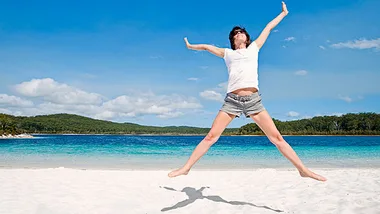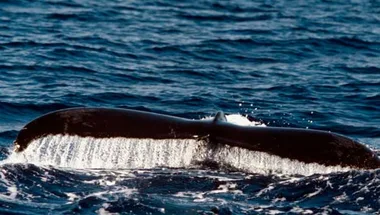If you want to get really close to whales, go to the Kingfisher Bay Resort on Fraser Island. A fascinating destination at any time of year, this World Heritage island and its world-famous eco-award-winning resort become irresistible drawcards between August and mid-October, when 1000 humpbacks stop for a long sojourn in the sheltered waters of Platypus Bay, on their annual trek from the Antarctic to the Great Barrier Reef. So numerous are the leviathans, some locals have renamed the bay “Whale Soup”. Many of the female humpbacks come to calf in the sheltered waters to the north-west of the island.
Brian Perry, of Hervey Bay Whale Watch, who organises whale-watching tours for the resort, says, “As far as humpback whales go, it’s probably the best place in the world.” Brian’s four-hour whale tours cover most of Hervey Bay, thanks to the sheer power of his craft. Quick Cat II, Australia’s most awarded whale-watching vessel, can travel at 22 knotts.
A favourite spot for whales to gather is Wathunba Creek, where fresh water pours into the sea from the island aquifers. Scientists believe that the low salinity here allows the whales to rid themselves of parasites. “Whether this is true or not,” says Brain, “you often find them acting up here – breaching, spy-hopping and waving their five-metre white fins at the boat.”
Whales or no whales (and the likelihood of getting up close and comfortable with these leviathans is very high at this time of year), Fraser Island is an unforgettable place to visit.
The largest sand island in the world, it’s home to lofty sub-tropical forests and freshwater lakes. Bordered by sand dunes, these lakes, namely MacKenzie and Wabby, are full of crystal-clear water, sapphire blue and emerald green, respectively.
Then, there’s 75-Mile Beach, a sand highway for four-wheel drive vehicles that runs 95km on the surf-side of this island. You can either drive up 75-Mile Beach to Indian Head to watch the sharks in the waters below, or take a stroll through the rainforest at Wanggoolba on the way.
Also highly recommended are the scenic flights that take off and land on the beach. This gives a spectacular eagle’s-eye view of the entire island and how its millions of tons of sand are fastened to mainland by a great plug of rock.
On the sheltered side of the island is the Kingfisher Bay Resort, sensitively developed in a forest overlooking the Great Sandy Strait and the mainland. Perfect for couples and family holidays, and catering for every budget, this resort balances eco-priorities, including great tours of the island, with self-contained villas and hotel rooms, and fine food in two restaurants.
Children can become Junior Eco Rangers and take part in a wide variety of activities – from nature walks, tennis, swimming, canoeing, cooking marshmallows around a camp fire, night spotlighting walks and guided beach tours.
There are 354 species of birds on the island and, during breakfast by the swimming pool, you’ll find flocks of them come along and have a good look at you in hope of catching a crumb.
For couples and families, there are personalised 4WD Tours around the island and fascinating nature walks in the surrounding bush. And visitors in search of romance can grab a picnic hamper and escape for the day or slip away to the beach at sunset for champagne.
Getting there: A 45-minute flight from Brisbane to Hervey Bay Airport, followed by a 40-minute boat trip from Hervey Bay to wharf at the Kingfisher Bay Resort.
Contact: www.kingfisherbay.com, phone 1800 072 555; www.herveybaywhalewatch.com.au; www.fraserisland.net; www.tq.com.au.
Newsletter conversion description. Get the latest in your inbox.
























.png?resize=380%2C285)
.jpg?resize=380%2C285)



.png?resize=380%2C285)
